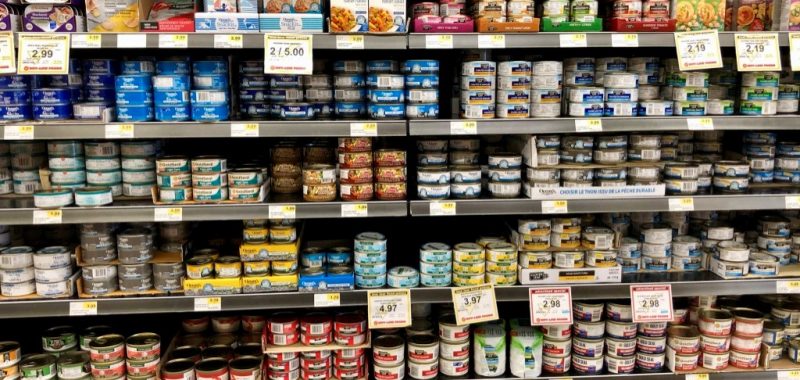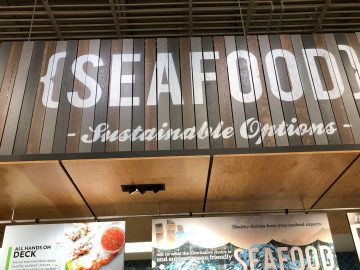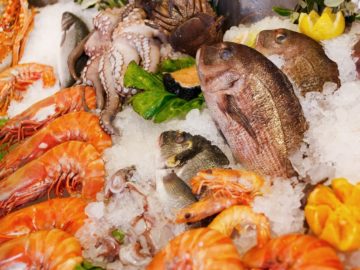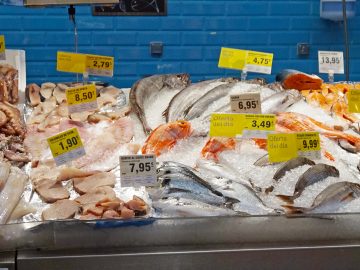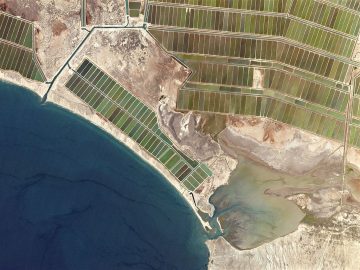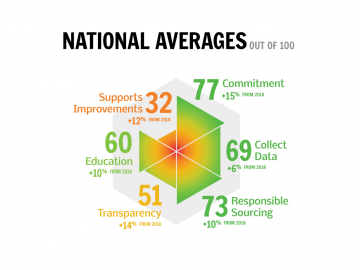Retailers have generally set strong commitments – though they may apply to fewer products than you thought.
On July 3rd, SeaChoice released our first annual update to Seafood Progress – an online resource that assesses and compares major Canadian food retailers’ sustainable seafood commitments and what they are doing against those commitments. Seafood Progress has six steps that follow the framework produced by the Conservation Alliance for Seafood Solutions in their Common Vision for Sustainable Seafood. This post is the first of a series that will look at each of the six steps in more detail, highlighting trends, shortcomings and leaders in action.
Step 1 is comprised of two indicators that assess the quality of a retailer’s environmental sustainability and social responsibility commitments. The indicators are designed to separate retailers that have “hand waving” commitments from those that have more robust and meaningful commitments. The scoring is additive, giving points for: clear objectives (as opposed to general, non-specific commitments), use of credible standards, actions or expectations for suppliers, a means of tracking products through the supply chain (“traceability”) to support the commitment and a timeline to achieve the commitment. These components reflect how concrete a retailer’s policies are and whether progress against them will be actionable and measurable.
These indicators do not, however, score the level of ambition of the commitments; a retailer could have a clear and specific commitment that has a timeline and traceability to support it, but still set a low bar and therefore limit their potential for impact ‘on the water’. In general, Seafood Progress assesses retailers against their commitments and their actions to meet their commitments – not against an idea of where their bar for sustainability should be.
In 2019, Step 1 continued to be the highest scoring step in Seafood Progress because most retailers have well-defined environmental sustainability commitments (national average or mean out of 100 = 87) and are developing more detailed social responsibility commitments (national average = 67). Three retailers – Loblaw, METRO and Walmart – have publicly available commitments that scored 100 for both indicators. However, despite many high scores, Seafood Progress found two main areas for general improvement.
The first issue that many retailers seem to be struggling with, particularly for their social responsibility commitments, is traceability. Traceability systems ensure that products do in fact meet a retailer’s sustainability bar, whether this means sourcing from eco-certified farms or fisheries, or from socially responsible producers or processors. Traceability systems should be part of a wider due diligence program on behalf of retailers to engage their business partners down the supply chain and work with them to ensure national laws, international standards and business-specific commitments are being upheld.
The second area for improvement is scope, i.e., which products the commitments apply to. Scope is not scored by Seafood Progress, but is integral to the impact retailers will have on seafood sustainability overall and whether they will meet their customers’ expectations. Over half of the retailers profiled in Seafood Progress don’t include any shelf-stable items (canned tuna, tinned anchovies, etc.) in their commitments to sustainable seafood. Excluding products like canned tuna is significant because Canadians eat a lot of canned tuna. In 2018, Canada imported nearly 40,000 tonnes of skipjack and albacore tuna* – the equivalent weight of 85,000 adult male polar bears – the vast majority of which will have been sold as shelf stable products.
Another important product segment that not all retailers’ commitments apply to is national brands. Well known national brands in Canada include Bluewater Seafood, High Liner and SeaQuest, and their products are typically sold frozen in boxes or bags covered by their own branding. Many of these companies have their own sustainability commitments (see the ‘Self Claims’ section of this recent post for more on those), which may or may not be in line with a retailer’s own policies. And while retailers can’t dictate the policies of independent companies, they can decide whether to carry their products in store.
Finally, some retailers are restricting the scope of their commitments by only applying them in some of their stores. Many of the retailers profiled in Seafood Progress own branded food stores, known as banners (for example, Safeway and IGA are banners of Sobeys, Real Canadian Superstore and Provigo are banners of Loblaw, etc.). Some retailers’ commitments only apply to a selection of their banners, meaning that even if the retailer has a good policy, it might not apply in all of their stores. Additionally, some retailers’ banners are franchised, meaning they may have even more autonomy to set their own policies.
As a first step, SeaChoice believes it is important that retailers are open and transparent about which products, in which stores, their commitments cover. This is critical for consumer trust. Next, we encourage those retailers whose commitments have limited scope to look into expanding them to cover more products, in more stores. We know that this won’t be easy, and that retailers who are reporting progress against their commitment may appear to be taking a step backwards as new products enter sustainability assessments. But this is the best way to take the guess work out of which products consumers can feel good about buying, and the best way to ensure ongoing and meaningful “seafood progress”.
(*from DFO trade statistics – 33,646 tonnes of skipjack tuna and 4,657 tonnes of albacore tuna)
Others in this series:
